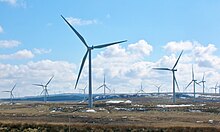
The production of renewable energy in Scotland is a topic that came to the fore in technical, economic, and political terms during the opening years of the 21st century.[2] The natural resource base for renewable energy is high by European, and even global standards, with the most important potential sources being wind, wave, and tide. Renewables generate almost all of Scotland's electricity, mostly from the country's wind power.[3]
In 2020, Scotland had 12 gigawatts (GW) of renewable electricity capacity, which produced about a quarter of total UK renewable generation.[4] In decreasing order of capacity, Scotland's renewable generation comes from onshore wind, hydropower, offshore wind, solar PV and biomass.[5] Scotland exports much of this electricity.[6][7] On 26 January 2024, the Scottish Government confirmed that Scotland generated the equivalent of 113% of Scotland's electricity consumption from renewable energy sources, making it the highest percentage figure ever recorded for renewable energy production in Scotland. It was hailed as "a significant milestone in Scotland's journey to net zero" by the Cabinet Secretary for Wellbeing Economy, Fair Work and Energy, Neil Gray. It becomes the first time that Scotland produced more renewable energy than it actually consumed, and demonstrates the "enormous potential of Scotland's green economy" as claimed by Gray.[8]
Continuing improvements in engineering and economics are enabling more of the renewable resources to be used. Fears regarding fuel poverty[9] and climate change have driven the subject high up the political agenda. In 2020 a quarter of total energy consumption, including heat and transportation, was met from renewables, and the Scottish government target is half by 2030.[10] Although the finances of some projects remain speculative or dependent on market incentives, there has been a significant—and, in all likelihood, long-term—change in the underpinning economics.[11][12]
In addition to planned increases in large-scale generating capacity using renewable sources, various related schemes to reduce carbon emissions are being researched.[13] Although there is significant support from the public, private and community-led sectors, concerns about the effect of the technologies on the natural environment have been expressed. There is also a political debate about the relationship between the siting, and the ownership and control of these widely distributed resources.[14][15]
- ^ "Whitelee Windfarm". ScottishPower Renewables. Retrieved 31 December 2020.
- ^ See, for example, Scottish Executive (2005) Choosing Our Future: Scotland's Sustainable Development Strategy. Edinburgh.
- ^ "Renewables met 97% of Scotland's electricity demand in 2020". BBC News. British Broadcasting Corporation. 25 March 2021. Retrieved 31 March 2021.
- ^ "BEIS Energy Trends – Renewables". UK Government. 26 March 2020. Retrieved 15 April 2020.
- ^ Cite error: The named reference
ScotRenNumberswas invoked but never defined (see the help page). - ^ "Proportion of electricity generation by fuel". Scottish Government: Scottish Energy Statistics Hub. Retrieved 15 April 2020.
- ^ "Share of renewable electricity in gross final consumption". Scottish Government: Scottish Energy Statistics Hub. Retrieved 15 April 2020.
- ^ "Record renewable energy output". www.gov.scot. Scottish Government. Retrieved 26 January 2024.
- ^ Wray, Ben (5 June 2022). "April Fuel's Day: Explaining Scotland's energy price rises". The National. Retrieved 11 July 2022.
- ^ "Energy statistics". www.gov.scot. Retrieved 11 July 2022.
- ^ Cite error: The named reference
Monbiotwas invoked but never defined (see the help page). - ^ Cite error: The named reference
Valentiwas invoked but never defined (see the help page). - ^ Cite error: The named reference
ESCCCwas invoked but never defined (see the help page). - ^ HICEC. (2006) Highlands and Islands Community Energy Company Annual Review. HICEC. Inverness. Archived 8 May 2007 at the Wayback Machine. (PDF). Retrieved 31 August 2007.
- ^ "Scottish communities reap £20m in benefits from renewable energy projects". Local Energy Scotland. Retrieved 15 April 2020.